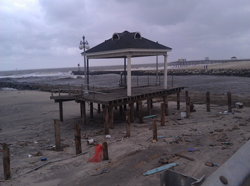Hannah Stone, 17, a resident of Oceanport, NJ evacuated her home on October 29 due to increasing winds approaching the East Coast. Her family fled to safer grounds as her waterfront home in Oceanport was issued a mandatory evacuation. However, by Tuesday morning, Hurricane Sandy had already engulfed the Stone’s home and left little behind.
“Only a few neighbors stayed, but nobody had lived quite as close to the water as we did” reports Hannah.
Hannah and her family live approximately five to 10 feet from the Shrewsbury River, resulting in inevitable flooding, and extreme devastation with winds being reported up to 80 mph by the National Hurricane Center.
“We had never anticipated that Hurricane Sandy would have caused so much damage to not only us, but many other families in the Jersey shore area,” said Stone.
However, many decided to stay, claiming that the hurricane would be as minor as Hurricane Irene, which hit the area in August of 2011.
“This was a relatively weak hurricane, but the fact that the storm was a hybrid is what caused all the devastation,” according to Joseph Gleason, local EMT volunteer for West Long Branch.
But what if you woke up on Tuesday and realized that this was a hurricane more comparable to Katrina? Imagine returning to the place you call home only to find your valuables submerged in water.
“I was devastated when I saw my house for the first time. It was so hard looking at something so important so ruined,” says Hannah as she remarks on Sandy’s aftermath.
With downed power lines and fallen trees and billions of dollars’ worth of damage, President Obama declared New Jersey and New York disaster areas, therefore allowing for federal aid from organizations like FEMA.
And to add to the disaster areas, approximately 2,498,447 million New Jersey people were without power according to the U.S. Department of Energy.
With the terrain worsened and electricity gone from so many, it was difficult for first responders like Gleason to attend to emergency calls.
He said, “If we had a call during the height of the storm the local police department would respond to our First Aid building in a Hummer and two EMT’s would go and treat the patient.”
Ambulances were inadequate for such conditions and the majority of those who needed assistance were people in need of oxygen. Luckily, local EMT’s were able to bring spare bottles to residents in need.
It’s difficult to reflect that many of us believed cabin fever was the worst of the storm. What if we had to clean, salvage and move our belongings much like Hannah and her family had done? The girl’s family lost irreplaceable possessions like her parents’ wedding album and childhood photos that could not be recovered.
But what did this disaster prove? In Hannah’s instance she said, “This hurricane allowed us to identify many good friends and maybe not so good friends that we have.”
Gleason also responds that, “The community was great. I heard a lot of stories about people offering extension cords off their generators to neighbors who didn’t have any to keep lights and refrigerators going.”
We have to realize that despite all that has occurred, Sandy has allowed us to rise together in order to embrace our family and friends.
“Although now may seem to be a time filled with difficult obstacles and frustration, the thought of eventually getting back to our home [in Oceanport] and being close to friends and school is what keeps not only me, but my family motivated to keep our heads up high throughout this entire experience,” Stone said. She plans to return to her home in six-nine months.
PHOTO COURTESY of Emily Taylor




